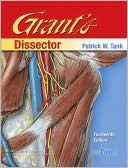Grant's Dissector
Search in google:
Since 1940, when Dr. J.C. Boileau Grant created the first lab manual based on Grant's method of dissection, Grant's Dissector has clearly established its authority and preeminence as the "gold standard" of gross anatomy dissection manuals. In the last edition, the material was streamlined to focus on more accurate, specific and clear steps, based on market conditions and feedback. This edition continues to focus on the trend of reduced lab hours yet maintains the quality and reliability of Grant's original manual.Grant's Dissector, Fourteenth Edition features over 40 new figures to provide consistent appearance and include additional details, and is cross-referenced to the leading anatomy atlases, including Grant's, Netter's, Rohen, and Clemente. Doody Review Services Reviewer: George C. Enders, PhD (University of Kansas Medical Center)Description: This is the 13th edition of a guide to the regional dissection of the human body for healthcare professional students. The 12th edition was published in 1999. Purpose: Grant's Dissector is designed to be used as a step-by-step guide to regional gross anatomy dissection of the human body for those in healthcare professions where gross anatomy often takes up a smaller part of the curricular time than in previous generations. The dissector is to be used simultaneously with a good textbook and an atlas. Audience: The dissector is designed principally for beginning medical, dental, and physical therapy students and other healthcare providers as their step-by-step guide to dissection of the human body to maximize the educational values of the cadavers. The author is the Director of the Division of Anatomical Education at the University of Arkansas for Medical Sciences. Features: This edition of this classic dissection approach (it has been used for more than 60 years by many medical schools) has been shortened without sacrificing clarity or content. A major advantage of this edition is that the dissection steps have been numbered, thereby allowing instructors to more accurately detail steps that they may want omitted or modified. The dissector contains a number of new illustrations specifically designed to aid the process of step-by-step dissection. The dissector chapter order starts with the back and spine. One of the advantages is each regional chapter is self-contained, so that courses which dissect in a different order than that followed by the book will still find the dissector useful. Each regional chapter starts with surface anatomy, then covers osteology, contains a "Before you dissect...," section containing dissection objectives, numbered step-by step procedures, and ends with "After you dissect...," section intended to improve student retention of knowledge. Most key anatomical structures are bolded which often end up serving as a de facto checklist for pre-exam review. Minor steps in the dissection approach have been modified, especially those that are often very destructive of more superficial structures. This edition has retained the cross references to the four most popular atlases to aid the dissection process. Assessment: The new authorship of the 13th edition has improved upon this time-honored classic dissector. It has retained its complete and thorough list of structures to be dissected and identified, but has done so in a more concise fashion, saving students' time.
INTRODUCTION THE BACK SURFACE ANATOMY SKELETON OF THE BACK SKIN AND SUPERFICIAL FASCIA SUPERFICIAL MUSCLES OF THE BACKINTERMEDIATE MUSCLES OF THE BACK DEEP MUSCLES OF THE BACK SUBOCCIPITAL REGION VERTEBRAL CANAL, SPINAL CORD, AND MENINGES THE UPPER LIMBSURFACE ANATOMY SUPERFICIAL VEINS AND CUTANEOUS NERVES SUPERFICIAL GROUP OF BACK MUSCLES SCAPULAR REGION PECTORAL REGION MUSCLES OF THE PECTORAL REGION AXILLA ARM AND CUBITAL FOSSA FLEXOR REGION OF THE FOREARM PALM OF THE HAND EXTENSOR REGION OF THE FOREARM AND DORSUM OF THE HAND JOINTS OF THE UPPER LIMB THE THORAXSURFACE ANATOMY SKELETON OF THE THORAX PECTORAL REGION INTERCOSTAL SPACE AND INTERCOSTAL MUSCLES REMOVAL OF THE ANTERIOR THORACIC WALL PLEURAL CAVITIES LUNGS THE ABDOMENSURFACE ANATOMY SUPERFICIAL FASCIA OF THE ANTEROLATERAL ABDOMINAL WALL MUSCLES OF THE ANTEROLATERAL ABDOMINAL WALL REFLECTION OF THE ABDOMINAL WALL PERITONEUM AND PERITONEAL CAVITY CELIAC TRUNK, STOMACH, SPLEEN, LIVER, AND GALLBLADDER SUPERIOR MESENTERIC ARTERY AND SMALL INTESTINE INFERIOR MESENTERIC ARTERY AND LARGE INTESTINE DUODENUM, PANCREAS, AND HEPATIC PORTAL VEIN REMOVAL OF THE GASTROINTESTINAL TRACT POSTERIOR ABDOMINAL VISCERA POSTERIOR ABDOMINAL WALL THE PELVIS AND PERINEUM SKELETON OF THE PELVIS ANAL TRIANGLE MALE EXTERNAL GENITALIA AND PERINEUM MALE UROGENITAL TRIANGLE MALE PELVIC CAVITY URINARY BLADDER, RECTUM, AND ANAL CANA INTERNAL ILIAC ARTERY AND SACRAL PLEXUSL FEMALE EXTERNAL GENITALIA AND PERINEUM FEMALE UROGENITAL TRIANGLE FEMALE PELVIC CAVITY URINARY BLADDER, RECTUM, AND ANAL CANAL INTERNAL ILIAC ARTERY AND SACRAL PLEXUS THE LOWER LIMBSURFACE ANATOMY SUPERFICIAL VEINS AND CUTANEOUS NERVES ANTERIOR COMPARTMENT OF THE THIGH MEDIAL COMPARTMENT OF THE THIGH GLUTEAL REGION POSTERIOR COMPARTMENT OF THE THIGH LEG AND DORSUM OF THE FOOT POSTERIOR COMPARTMENT OF THE LEG LATERAL COMPARTMENT OF THE LEG ANTERIOR COMPARTMENT OF THE LEG AND DORSUM OF THE FOOT SOLE OF THE FOOT JOINTS OF THE LOWER LIMB THE HEAD AND NECKNECK POSTERIOR TRIANGLE OF THE NECK ANTERIOR TRIANGLE OF THE NECK THYROID AND PARATHYROID GLANDS ROOT OF THE NECK HEAD Skull FACE PAROTID REGION SCALP TEMPORAL REGION INTERIOR OF THE SKULL REMOVAL OF THE BRAIN DURAL INFOLDINGS AND DURAL VENOUS SINUSES GROSS ANATOMY OF THE BRAIN CRANIAL FOSSAE ORBIT CRANIOVERTEBRAL JOINTS AND DISARTICULATION OF THE HEAD PHARYNX NOSE AND NASAL CAVITY HARD PALATE AND SOFT PALATE ORAL REGION LARYNX EAR Index








